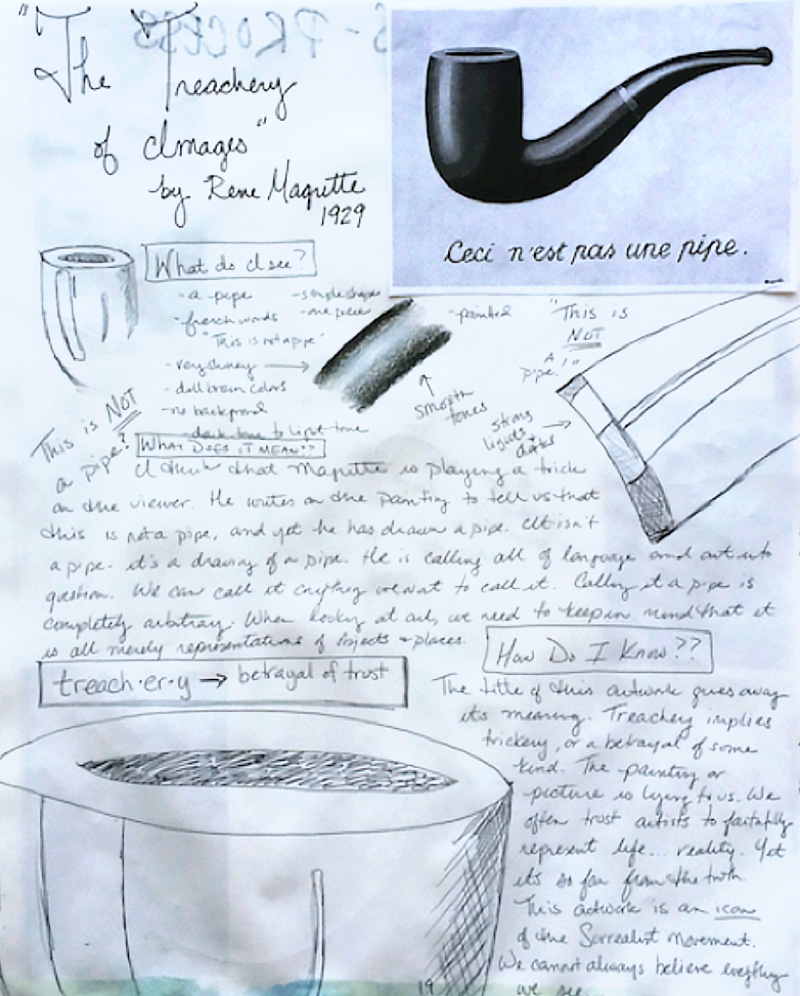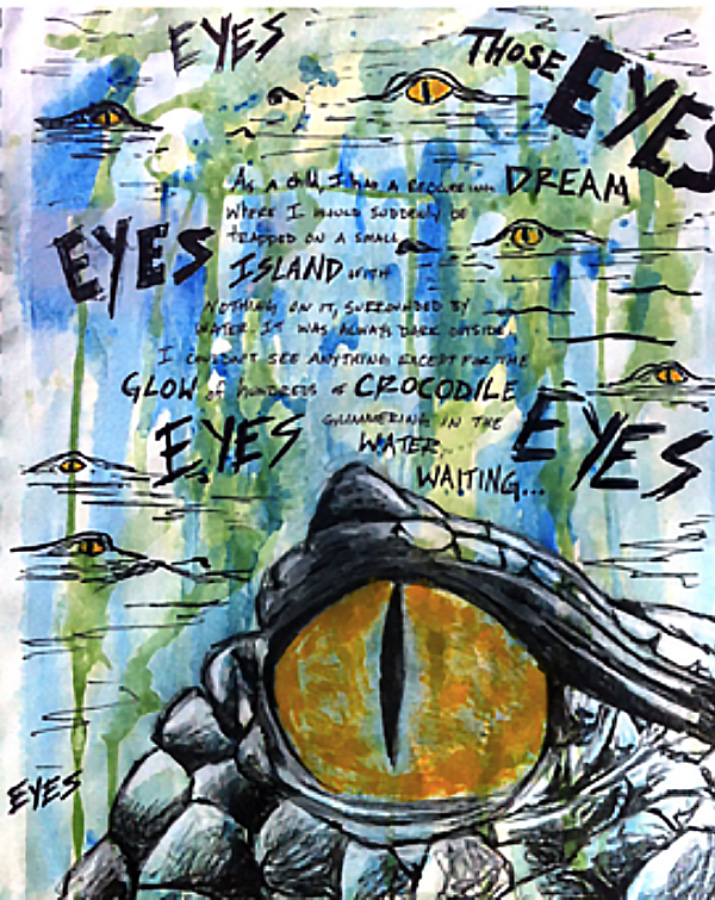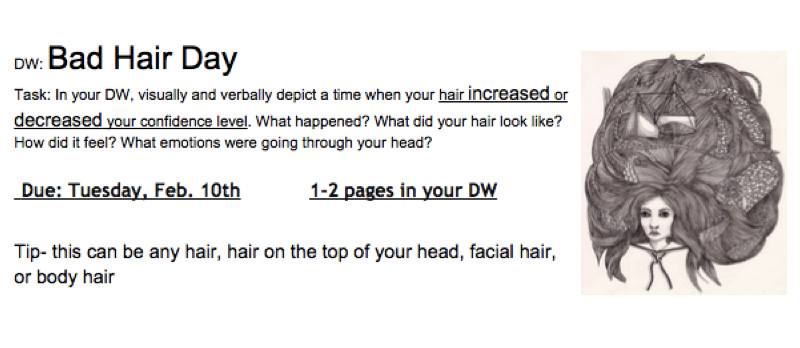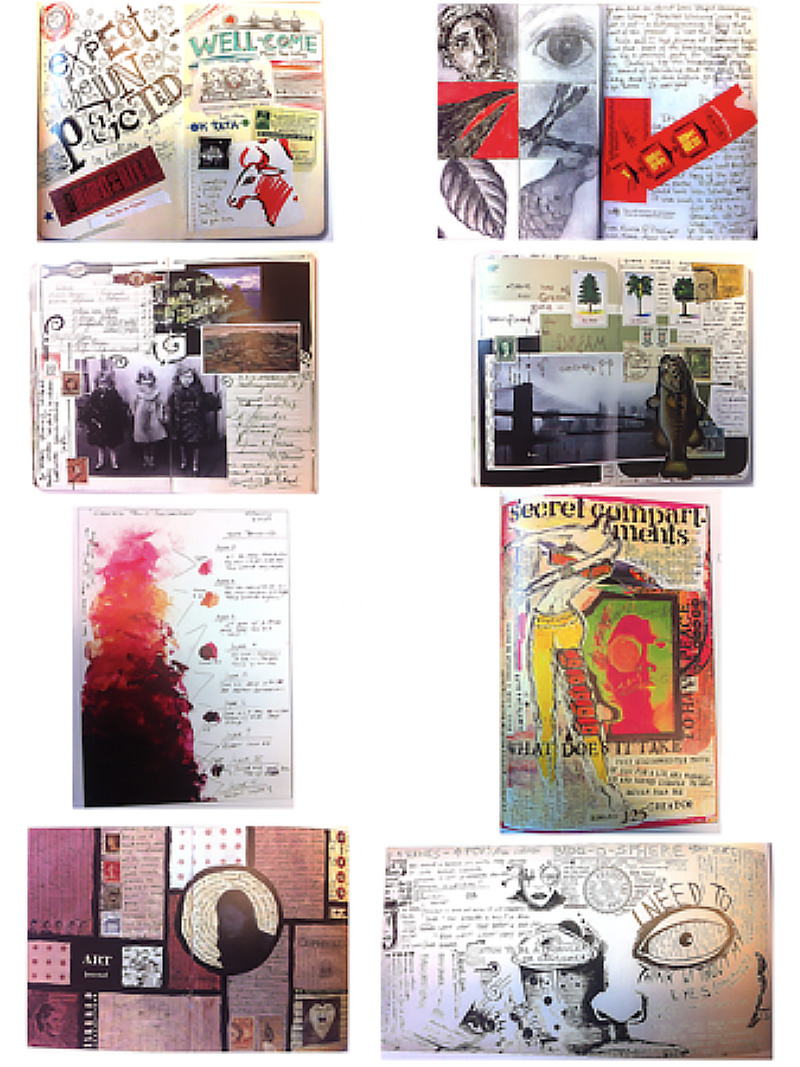Routine vs. Ritual
High-school students reflect in daily workbooks during a yearlong journaling project.
By Bridget Alexander

So many of our daily actions and reactions seem routine, but when does a routine become a ritual?
My goal for this school year was to create a mental workspace where reflection on routines in my students’ daily lives could occur. As an International Baccalaureate school, Back of the Yards College Prep requires a certain amount of documentation and writing to prepare our students for the rigorous Diploma Program; using their sketchbook became an essential, routine, part of our classroom time. Over the year, I have had my students start a new routine, reflecting and recording stories of daily life in their sketchbooks. They use their sketchbook as a journal, recording their thoughts, reflections, notes, and questions. Our end goal is to examine these routines and discuss how many of them are actual ritualistic or have a ritualistic quality. This leads the students to think and work like artists.

- Students will be able to take their recorded reflections and notes from the sketchbook and examine the true meaning of routine and, by doing so, be able to generate a greater understanding of humans, particularly students, being ritualistic beings.
Documentation + Assessment Suggestions
The Daily Workbooks function as both assignment and documentation. The goal in getting the students to use their DW on a regular basis is to create the mindset of how an artist works and thinks. By being able to step away from their creative practice, reflecting, and documenting, students can see the breadth they have explored throughout the school year.
Learning Activities
Over the course of the year, students use their Daily Workbook (DW) to record thoughts, project progression, strengths, and failures. The act of recording and reflecting fuels our conversation around this central idea of routine versus ritual. Below is a selection from the scope and sequence of the themes we have covered this year. Each unit includes at least 2 Daily Workbook assignments, which also function as a biweekly assessment. The assignments range from reflecting on a work of art, to discussing a childhood memory, to automatic writing and drawing. Assignments are often tied to the general themes from our units but at times tie to current events in the school or in the news.
For a more detailed explanation of each theme as it fits into the larger unit, please download the Full Unit Plan.
Surrealist Layers [4 weeks]
Surrealist artists often harness their subconscious creativity through play and risk-taking in order to create works of art.
Themes in our Daily Workbook:
- Dream Journal
- Risk-taking
- Technology
- Surrealist Art Study
- Seeing into Maps
- Poem of Opposites
- Fumage / Seeing into
- Surrealist Music video: notes and imagery
- New Vocabulary
- Surrealism notes
Nomadic Tribes [6 weeks: 4 weeks for characters, 2 weeks for "world"]
Artists explore various ways of creating and cultivating authentic characters, with unique and imaginative cultural development.
Themes in our Daily Workbook:
- Character creation sketches
- Risk
- Trading Cards
- Contour Line Sketches
- New Vocabulary
- Art Study
- “Play” within
- Creating Culture
Intro to Drawing: Perspective vs Perception [6 weeks]
Artists replicate and manipulate reality through the use of various drawing media while challenging the idea of perception.
Themes in our Daily Workbook:
- History of Perspective
- New Vocabulary
- One-, Two-, and Three-Point Vanishing Examples
- Perspective vs. perception
- Renaissance notes
- Illusion
Good Hair? [4 weeks]
Artists often embrace or challenge the social norms and constructs/ stereotypes that are embodied in their culture.
Themes in our Daily Workbook:
- Movie Notes
- Bad Hair Day
- Texture Exploration
- Positive and Negative Space Drawing
- Hair Study
- Art Study
- Photo Documentation of Hair
- Stereotype Venn Diagram
- Social Constructs List



Materials + Supplies
Students are free to use any materials. I often recommend building a background first and moving from there. The major requirement is that students use both visuals and text to complete the assignments.
MCA Connections
The Daily Workbooks can travel to the MCA for use before, during, and after field trips. The themes for daily entries can be adapted to any project or journey in your teaching.
Resources
Bridget Alexander
Back of the Yards CP
Bridget Morawski Alexander is a graduate of the University of Illinois at Chicago. Under the instruction of Olivia Gude, Bridget was a teacher at UIC's Spiral Workshop and worked collaboratively with the 2010 Liminality faculty, Robert Anderson and Alex Sutphen. Bridget taught Art and English at Our Lady of Tepeyac High School in Chicago's Little Village for three years. For the 2014-2015 school year, Bridget was hired as a Fine Arts Sculpture teacher at the Back of the Yards College Preparatory High School. Bridget looks forward to challenging herself with graduate school in the upcoming years and loves to keep her art-making practice strong, with experimentation in printmaking and craft multimedia projects.
Bridget reflects on her creative process:
When I first conceived my project I was working at a different school. At the beginning of the Teacher Institute I was just offered a new job with CPS. I had a very singular focus when applying for the Teacher Institute. I planned on having my students create a found-object sculpture to explore daily routines. Once I received my new job, I was no longer solely in charge of my own classroom’s curriculum. At the beginning of the institute, I was thrown. I was not sure what my school year would look like or how I would be able to include my project in my curriculum. I figured the easiest way to make my project work was to make it an overall theme for the year instead of a singular project.
The Teacher Institute is a much-needed energy boost for the beginning of the school year. Mentally and emotionally challenging, the Teacher Institute was a much-needed gift for me this year. I was at a point where I had become too comfortable in my lessons, not pushing my students or myself.
Looking to the future, I would create a more tangible concept for a project, one that I mentally could wrap my head around and one that truly tracks my students’ responses. That said, I feel as if I am a better educator, pushing my students and myself to a much deeper understanding of contemporary art and interpretation. My lesson plans and units are diving into a more complex mental space, allowing for growth in the future.
